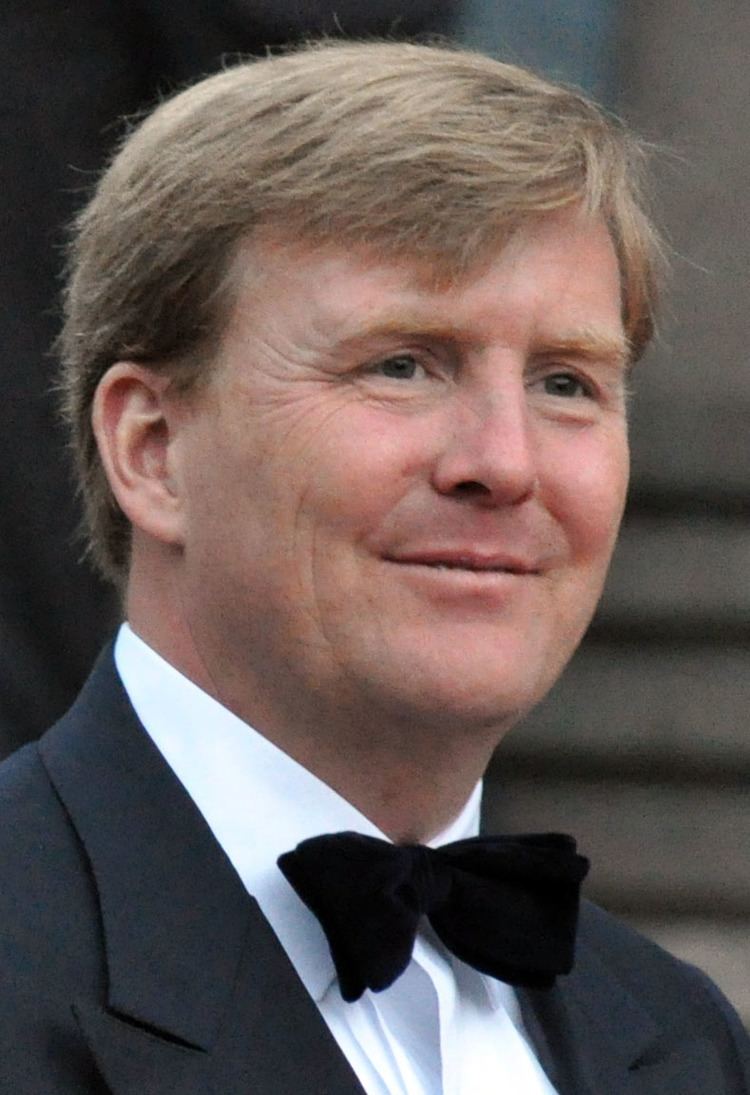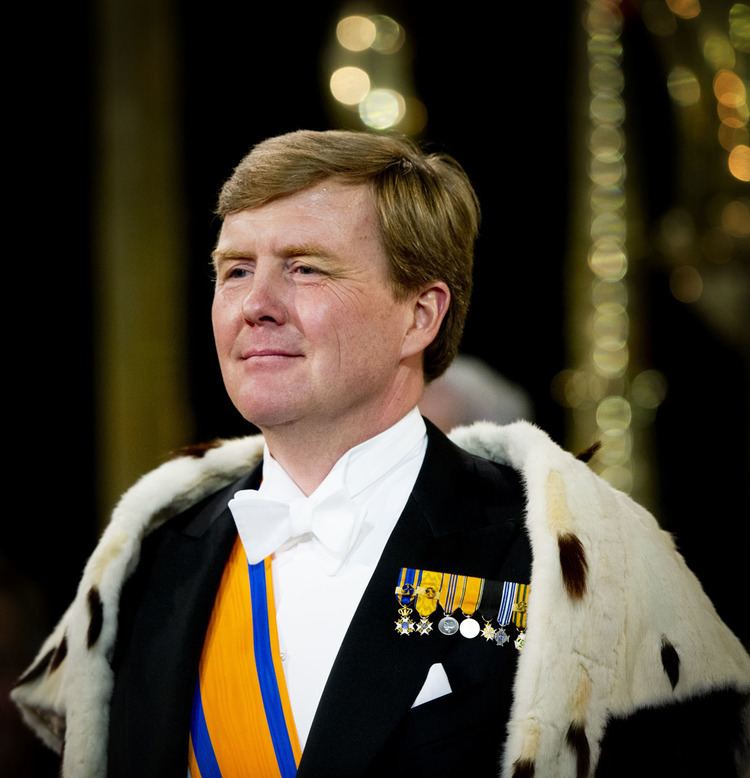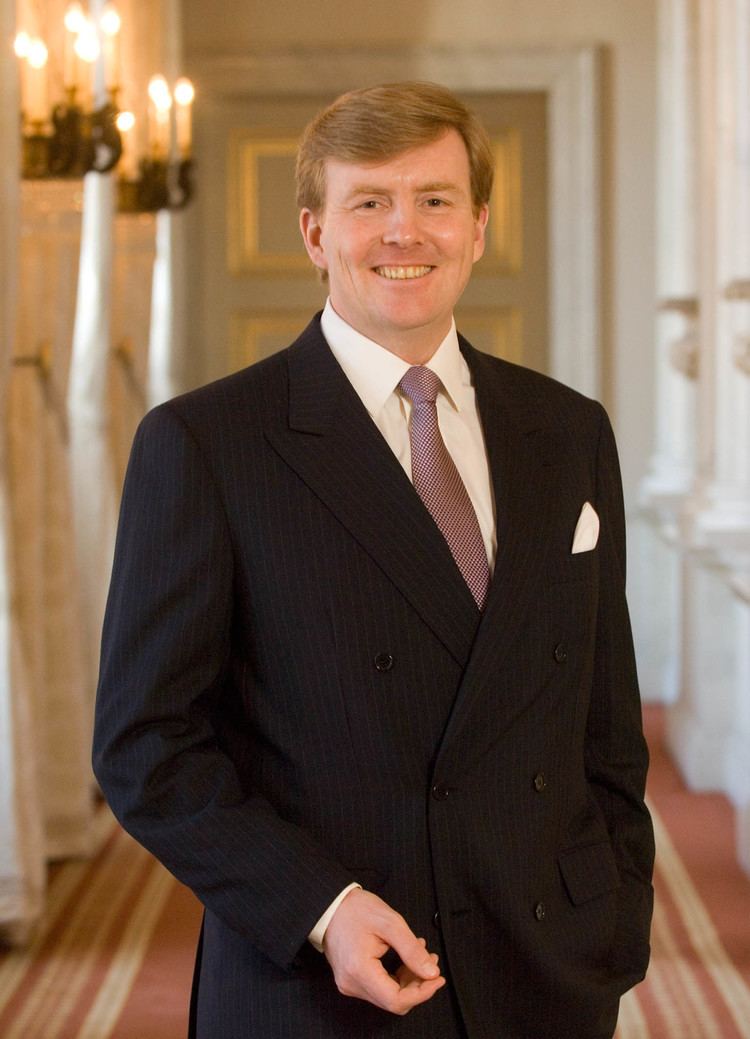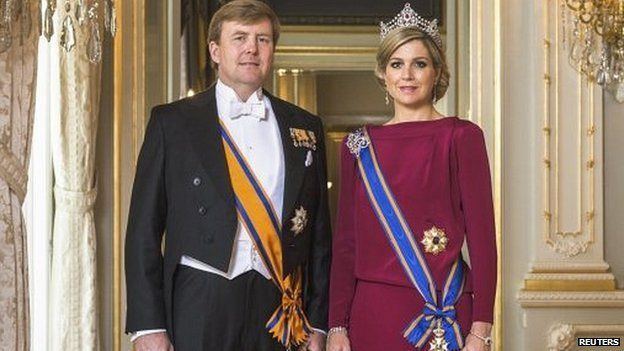Inauguration 30 April 2013 Predecessor Beatrix | Heir apparent Catharina-Amalia | |
 | ||
Reign 30 April 2013 – present IssueDetail Catharina-Amalia, Princess of OrangePrincess AlexiaPrincess Ariane Spouse Queen Maxima of the Netherlands (m. 2002) Parents Prince Claus of the Netherlands, Beatrix of the Netherlands Children Catharina-Amalia, Princess of Orange, Princess Alexia of the Netherlands, Princess Ariane of the Netherlands Similar People Queen Maxima of the Nethe, Beatrix of the Netherlands, Catharina‑Amalia - Princess of Orange, Prince Friso of Orange‑Nassau, Princess Alexia of the Nethe | ||
King willem alexander of the netherlands cycling
Willem-Alexander ([ˈʋɪləm aːlɛkˈsɑndər]; Willem-Alexander Claus George Ferdinand; born 27 April 1967) is The King of the Netherlands.
Contents
- King willem alexander of the netherlands cycling
- Early life and education
- Military training and career
- Activities and social interests
- Reign
- Leisure activities
- Marriage and children
- Privacy and the press
- Properties
- The villa in Manchagulo
- Titles and styles
- Military ranks
- Qualifications
- National Honours
- Foreign honours
- Awards
- Honorary appointment
- Ancestry
- References

King Willem-Alexander was born in Utrecht and is the oldest child of Princess (former Queen) Beatrix and German diplomat Claus van Amsberg. He became Prince of Orange as heir apparent upon his mother's accession on 30 April 1980, and succeeded her following her abdication on 30 April 2013.

He went to public primary and secondary schools, served in the Royal Netherlands Navy, and studied History at Leiden University. He married Máxima Zorreguieta Cerruti in 2002 and they have three daughters: Catharina-Amalia, Princess of Orange (born 2003), Princess Alexia (born 2005), and Princess Ariane (born 2007).

Willem-Alexander is interested in sports and international water management issues. Until his accession to the throne, he was a member of the International Olympic Committee (1998–2013), chairman of the Advisory Committee on Water to the Dutch Minister of Infrastructure and the Environment (2004–2013), and chairman of the Secretary-General of the United Nations' Advisory Board on Water and Sanitation (2006–2013). At the age of 50, he is currently the second youngest monarch in Europe after Felipe VI of Spain.

Early life and education

Willem-Alexander Claus George Ferdinand was born on 27 April 1967 in the Utrecht University Hospital, now the University Medical Center Utrecht in Utrecht, Netherlands. He is the first child of Princess Beatrix and Prince Claus, and the first grandchild of Queen Juliana and Prince Bernhard. He was the first male Dutch royal baby since the birth of Prince Alexander in 1851, and the first immediate male heir since Alexander's death in 1884.

From birth, Willem-Alexander has held the titles Prince of the Netherlands (Dutch: Prins der Nederlanden), Prince of Orange-Nassau (Dutch: Prins van Oranje-Nassau), and Jonkheer of Amsberg (Dutch: Jonkheer van Amsberg). He was baptised as a member of the Dutch Reformed Church on 2 September 1967 in Saint Jacob's Church in The Hague. His godparents are Prince Bernhard of Lippe-Biesterfeld, Gösta Freiin von dem Bussche-Haddenhausen, Ferdinand von Bismarck, former Prime minister Jelle Zijlstra, Jonkvrouw Renée Röell, and Queen Margrethe II of Denmark.

He had two younger brothers: Prince Friso (1968–2013) and Prince Constantijn (born in 1969). He lived with his family at the castle Drakensteyn in the hamlet Lage Vuursche near Baarn from his birth until 1981, when they moved to the larger palace Huis ten Bosch in The Hague. His mother Beatrix became Queen of the Netherlands in 1980, after his grandmother Juliana abdicated. He then received the title of Prince of Orange as heir apparent to the throne of the Kingdom of the Netherlands.
Willem-Alexander attended Nieuwe Baarnse Elementary School in Baarn from 1973 to 1979. He went to three different secondary schools: the Baarns Lyceum in Baarn from 1979 to 1981, the Eerste Vrijzinnig Christelijk Lyceum in The Hague from 1981 to 1983, and the United World College of the Atlantic in Wales, the UK (1983 to 1985), from which he received his International Baccalaureate.
After his military service from 1985 to 1987, Willem-Alexander studied History at Leiden University from 1987 onwards and received his MA degree (doctorandus) in 1993. His final thesis was on the Dutch response to France's decision under President Charles de Gaulle to leave the NATO's integrated command structure.
Willem-Alexander speaks English, Spanish and German in addition to his native Dutch.
Military training and career
Between secondary school and his university education, Willem-Alexander performed military service in the Royal Netherlands Navy from August 1985 until January 1987. He received his training at the Royal Netherlands Naval College and the frigates HNLMS Tromp and HNLMS Abraham Crijnssen, where he was an ensign. In 1988 he received additional training at the ship HNLMS Van Kinsbergen and became a lieutenant (junior grade) (wachtofficier).
As a reservist for the Royal Netherlands Navy, Willem-Alexander was promoted to Lieutenant Commander in 1995, Commander in 1997, Captain at Sea in 2001, and Commodore in 2005. As a reservist for the Royal Netherlands Army, he was made a Major (Grenadiers' and Rifles Guard Regiment) in 1995, and was promoted to Lieutenant Colonel in 1997, Colonel in 2001, and Brigadier General in 2005. As a reservist for the Royal Netherlands Air Force, he was made Squadron Leader in 1995 and promoted to Air Commodore in 2005. As a reservist for the Royal Marechaussee, he was made Brigadier General in 2005.
Before his investiture as king in 2013, Willem-Alexander was honorably discharged from the armed forces. The government declared that the head of state cannot be a serving member of the armed forces, since the government itself holds supreme command over the armed forces. As king, Willem-Alexander may choose to wear a military uniform with royal insignia, but not with his former rank insignia.
Activities and social interests
Since 1985, when he became 18 years old, Willem-Alexander has been a member of the Council of State of the Netherlands. This is the highest council of the Dutch government and is chaired by the head of state (then Queen Beatrix).
King Willem-Alexander is interested in water management and sports issues. He was an honorary member of the World Commission on Water for the 21st century and patron of the Global Water Partnership, a body established by the World Bank, the UN, and the Swedish Ministry of Development. He was appointed as the Chairperson of the United Nations Secretary General's Advisory Board on Water and Sanitation on 12 December 2006.
On 10 October 2010, Willem-Alexander and Máxima went to the Netherlands Antilles' capital, Willemstad, to attend and represent his mother, the Queen, at the Antillean Dissolution ceremony.
He was a patron of the Dutch Olympic Games Committee until 1998 when he was made a member of the International Olympic Committee (IOC). After becoming King, he relinquished his membership and received the Gold Olympic Order at the 125th IOC Session. To celebrate the 100th anniversary of the 1928 Summer Olympics held in Amsterdam, he has expressed support to bid for the 2028 Summer Olympics.
He was a member of the supervisory board of De Nederlandsche Bank (the Dutch central bank), a member of the Advisory Council of ECP (the information society forum for government, business and civil society), patron of Veterans' Day and held several other patronages and posts.
Reign
On 28 January 2013, Beatrix announced her intention of abdicating. On the morning of 30 April, Beatrix signed the instrument of abdication at the Moseszaal (Moses Hall) at the Royal Palace of Amsterdam. Later that afternoon, Willem-Alexander was inaugurated as king in front of the joint assembly of the States General in a ceremony held at the Nieuwe Kerk.
As king, Willem-Alexander has weekly meetings with the prime minister and speaks regularly with ministers and state secretaries. He also signs all new Acts of Parliament and royal decrees. He represents the kingdom at home and abroad. At the State Opening of Parliament, he delivers the Speech from the Throne, which announces the plans of the government for the parliamentary year. The Constitution requires that the king appoint, dismiss and swear in all government ministers and state secretaries. As king, he is also the president of the Council of State, an advisory body that reviews proposed legislation. In modern practice, the monarch seldom chairs council meetings.
At his accession at age 46, he was Europe's youngest monarch. On the Inauguration of Spain's Felipe VI on 19 June 2014 he became, and remains, Europe's second youngest monarch. He is also the first male monarch of the Netherlands since the death of his great-great-grandfather William III in 1890. Willem-Alexander was one of four new monarchs to take the throne in 2013 along with Pope Francis, the Emir Tamim bin Hamad of Qatar, and King Philippe of Belgium.
Leisure activities
Willem-Alexander is an avid pilot and has said that if he had not been a royal, he would have liked to be an airline pilot so he could fly big planes such as the Boeing 747. In 1989, Willem-Alexander flew as a volunteer for the African Medical Research and Education Foundation (AMREF) in Kenya, and in 1991 he spent a month flying for the Kenya Wildlife Service. During the reign of his mother, he regularly flew the Dutch royal airplane on trips.
In May 2017, Willem-Alexander revealed that he had served as a co-pilot on KLM flights for 21 years, flying KLM Cityhopper's Fokker 70s twice a month, even after his ascension to the throne. With KLM's phased retirement of the Fokker 70, he began training to fly Boeing 737s. Willem-Alexander was rarely recognized while in the KLM uniform and wearing the KLM cap, though a few passengers had recognized his voice, even though he never gave his name and only welcomed passengers on behalf of the captain and crew.
Using the name "W. A. van Buren", one of the least-known titles of the House of Orange-Nassau, he participated in the 1986 Frisian Elfstedentocht, a 200 kilometres (120 mi) long ice skating tour. He ran the New York City Marathon under the same pseudonym in 1992.
Marriage and children
On 2 February 2002, he married Máxima Zorreguieta Cerruti at the Nieuwe Kerk in Amsterdam. Máxima is an Argentine woman of Basque, Portuguese and Italian ancestry, who prior to their marriage worked as an investment banker in New York City. The marriage triggered significant controversy due to the role the bride's father, Jorge Zorreguieta, had in the Argentinian military dictatorship. The couple have three daughters:
Privacy and the press
In an attempt to strike a balance between privacy for the royal family and availability to the press, the Netherlands Government Information Service (RVD) instituted a media code on 21 June 2005 which essentially states that:
During a ski vacation in Argentina, several photographs were taken of the prince and his family during the private part of their holiday, including one by Associated Press staff photographer Natacha Pisarenko, in spite of the media code, and after a photo opportunity had been provided earlier. The Associated Press decided to publish some of the photos, which were subsequently republished by several Dutch media. Willem-Alexander and the RVD jointly filed suit against the Associated Press on 5 August 2009, and the trial started on 14 August at the district court in Amsterdam. On 28 August, the district court ruled in favour of the prince and RVD, citing that the couple has a right to privacy; that the pictures in question add nothing to any public debate; and that they are not of any particular value to society since they are not photographs of his family "at work". Associated Press was sentenced to stop further publication of the photographs, on pain of a €1,000 fine per violation with a €50,000 maximum.
Properties
The royal family currently lives in Villa Eikenhorst on the De Horsten estate in Wassenaar. After the move of Princess Beatrix to the castle of Drakensteyn and a renovation, Willem-Alexander and his family will move to the palace of Huis ten Bosch in The Hague.
Willem-Alexander has a villa near Kranidi, Greece. Former actor Sean Connery has his own house nearby.
The villa in Manchagulo
On 10 July 2008, the Prince of Orange and Princess Maxima announced that they had invested in a development project on the Mozambican peninsula of Machangulo. The development project was aimed at building an ecologically responsible vacation resort, including a hotel and several luxury vacation houses for investors. The project was to invest heavily in the local economy of the peninsula (building schools and a local clinic) with an eye both towards responsible sustainability and maintaining a local staff. After contacting Mozambican president Armando Guebuza to verify that the Mozambican government had no objections, the couple decided to invest in two villas. In 2009, controversy erupted in parliament and the press about the project and the prince's involvement. Politician Alexander Pechtold questioned the morality of building such a resort in a poor country like Mozambique. After public and parliamentary controversy the royal couple announced that they decided to sell the property in Machangulo once their house was completed. In January 2012, it was confirmed that the villa had been sold.
Titles and styles
His style and title, as appearing in preambles, is: "Willem-Alexander, by the Grace of God, King of the Netherlands, Prince of Orange-Nassau, etc. etc. etc." The triple 'etc.' refers to the Dutch monarch's other titles.
Willem-Alexander is the first Dutch king since Willem III, who died in 1890. Willem-Alexander had earlier indicated that when he became king, he would take the name Willem IV, but it was announced on 28 January 2013 that his regnal name would be Willem-Alexander.
Military ranks
Qualifications
National Honours
Foreign honours
Awards
Honorary appointment
Ancestry
Through his father, a member of the House of Amsberg, he is descended from families of the lower German nobility, and through his mother, from several royal German/Dutch families such as the House of Lippe, Mecklenburg-Schwerin, the House of Orange-Nassau, Waldeck and Pyrmont, and the House of Hohenzollern. He is descended from the first King of the Netherlands, William I of the Netherlands, who was also a ruler in Luxembourg and several German states, and all subsequent Dutch monarchs. By his mother, Willem-Alexander also descended from Paul I of Russia and thus from German princess Catherine the Great. Through his father, he is also descended from several Dutch/Flemish families who left the Low Countries during Spanish rule, such as the Berenbergs. His paternal great-great-grandfather Gabriel von Amsberg (1822–1895), a Major-General of Mecklenburg, was recognized as noble as late as 1891, the family having adopted the "von" in 1795.
King Willem-Alexander is a descendant of King George II and more relevant for his succession rights of his granddaughter Princess Augusta of Great Britain. Under the British Act of Settlement, King Willem-Alexander temporarily forfeited his (distant) succession rights to the throne of the United Kingdom by marrying a Roman Catholic. This right has since been restored in 2015 under the Succession to the Crown Act 2013.
He is King of the Netherlands because he represents the most direct descendant of the brother of William the Silent, the leader of the Dutch Independence movement, acceptable to the citizens of the Netherlands.
